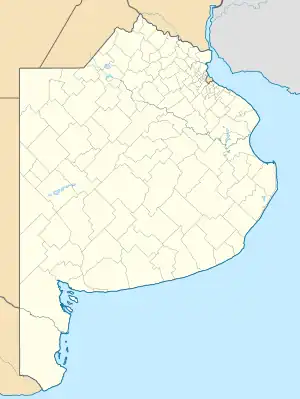| Samborombón Bay | |
|---|---|
| Bahía de Samborombón (Spanish) | |
 Visible as a C-shaped indentation in the coast near the southern end of the Río de la Plata estuary | |
 Samborombón Bay | |
| Location | South America |
| Coordinates | 35°54′S 57°05′W / 35.900°S 57.083°W |
| River sources | Salado River, Samborombón River |
| Ocean/sea sources | Argentine Sea, South Atlantic Ocean |
| Basin countries | Argentina |
| Max. width | 135 km (84 mi) |
| Surface area | 2,500 km2 (970 sq mi)[1] |
| Settlements | General Lavalle, San Clemente del Tuyú |
| Official name | Bahía de Samborombón |
| Designated | 24 January 1997 |
| Reference no. | 885[2] |
Samborombón Bay (Spanish: Bahía de Samborombón[3]) is a bay on the coast of Buenos Aires Province, Argentina. Located at the Río de la Plata's mouth on the Argentine Sea, it begins about 160 kilometres (99 mi) southeast of Buenos Aires and is about 135 kilometres (84 mi) wide.[4]
Toponymy
The bay is thought to have been named in 1520 by members of Ferdinand Magellan's expedition, who attributed its nearly semicircular shape to the detachment of legendary Saint Brendan's Island from the South American mainland ("Samborombón" being a corruption of San Borondón).[5] The Samborombón River and the town of Samborombón share the bay's name.[6][7]
Geography
Samborombón Bay is located at the mouth of the Río de la Plata, stretching from Punta Piedras in the north to Punta Rasa in the south, where Cape San Antonio begins.[4][8] Depending on the boundaries used, the bay can be considered an estuary stretch of the Río de la Plata or a large bay of the Argentine Sea; the International Hydrographic Organization defines the eastern boundary of the Río de la Plata as "a line joining Punta del Este, Uruguay and Cabo San Antonio, Argentina,"[9] a definition which includes Samborombón Bay as part of the river.[10]
Hydrology
The bay receives inflow from the Southern Salado River, the Samborombón River, and other smaller streams, as well as numerous artificial canals constructed to drain eastern Buenos Aires Province.[4] It also experiences a substantial flow of water coming out from the Río de la Plata into the Argentine Sea.[11]
Conservation
Samborombón Bay exhibits an unusually high density of shorebird species, many of which use the bay as a stopping point in their seasonal migrations.[12] It also serves as an important nursery habitat for fish species in the Río de la Plata estuary system.[13] The bay and the adjoining coastal region are included in a number of protected areas because of the well preserved Pampas grassland and wetland ecosystems that characterize the area.[14]
The Province of Buenos Aires' Provincial Body for Sustainable Development has designated the central portion of the coast as the Samborombón Bay Provincial Nature Reserve because of its importance as a wildlife refuge;[15] parts of the southern coast are included in the Rincón de Ajó Provincial Nature Reserve.[16] The bay is also designated as a Western Hemisphere Shorebird Reserve Network Site of International Importance, as well as a Ramsar Wetland of International Importance, reflecting its significance as a habitat for the buff-breasted sandpiper and other threatened species.[1] The southern shore includes Campos del Tuyú National Park, home to a population of rare Pampas deer.[17]
Recreation
The Samborombón Bay coast is known for its excellent sport fishing, particularly in the waters near Punta Rasa and the town of General Lavalle, where large saltwater species such as black drum are abundant.[18]
References
- 1 2 "Bahía Samborombón". Western Hemisphere Shorebird Reserve Network. Retrieved 25 May 2017.
- ↑ "Bahía de Samborombón". Ramsar Sites Information Service. Retrieved 25 April 2018.
- ↑ Bahía Samborombón at GEOnet Names Server
- 1 2 3 "Samborombón Bay". Encyclopædia Britannica. Retrieved 25 May 2017.
- ↑ Sánchez Zinny, Fernando (21 July 2012). "Una leyenda anclada en la bahía de Samborombón". La Nación (in Spanish). Retrieved 30 May 2017.
- ↑ Hernández González, Fremiot (2006). La navegación de san Brendán (in Spanish). Ediciones Akal. p. 7. ISBN 8446013398.
- ↑ Gabriela, Gresores; Birocco, Carlos M. (1992). Arrendamientos desalojos y subordinación campesina: elementos para el análisis de la campaña bonaerense en el siglo XVIII (in Spanish). F. García Cambeiro. p. 11.
- ↑ "Punta Rasa en San Clemente del Tuyú". Welcome Argentina (in Spanish). Retrieved 8 June 2017.
- ↑ "Limits of Oceans and Seas, 3rd edition" (PDF). International Hydrographic Organization. 1953. Retrieved 29 December 2020.
- ↑ "FREPLATA Transboundary Diagnostic Analysis: Synthesis for Policymakers" (PDF). International Waters learning Exchange & Resource Network. United Nations Development Programme Global Environmental Finance Unit. December 2006. p. 11. Retrieved 26 February 2018.
- ↑ Perillo, Gerardo M.E.; Piccolo, Maria C.; Pino-Quivira, Mario (2012). Estuaries of South America: Their Geomorphology and Dynamics. Springer Science & Business Media. pp. 170–1. ISBN 9783642601316. Retrieved 25 May 2017.
- ↑ Martínez-Curci, Natalia S.; Isacch, Juan P.; Azpiroz, Adrián B. (2015). "Shorebird Seasonal Abundance and Habitat-Use Patterns in Punta Rasa, Samborombón Bay, Argentina". Waterbirds. 38 (1): 68–76. doi:10.1675/063.038.0109. hdl:11336/50690. S2CID 84298518.
- ↑ Lasta, C.; Gagliardini, D.; Milovich, J.; Acha, E. M. (Winter 1996). "Seasonal Variation Observed in Surface Water Temperature of Samborombón Bay, Argentina, Using NOAA-AVHRR and Field Data". Journal of Coastal Research. 12 (1): 18–25. JSTOR 4298456.
- ↑ "Samborombon Bay". Birding Buenos Aires. Retrieved 25 May 2017.
- ↑ "Reserva Natural Bahía Samborombón". Organismo Provincial para el Desarrollo Sostenible (in Spanish). Retrieved 17 July 2017.
- ↑ "Reserva Natural Rincón de Ajó". Organismo Provincial para el Desarrollo Sostenible (in Spanish). Retrieved 17 July 2017.
- ↑ "Campos del Tuyú". Patrimonio Natural (in Spanish). Retrieved 8 June 2017.
- ↑ "La pesca en Samborombón". Welcome Argentina (in Spanish). Retrieved 30 May 2017.
External links
- Map of Samborombón Bay and its various protected areas from the Argentine National Parks Administration